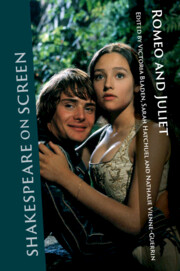Book contents
- Shakespeare on Screen: Romeo and Juliet
- Series page
- Shakespeare on Screen: Romeo and Juliet
- Copyright page
- Dedication
- Contents
- Figures
- Notes on Contributors
- Series Editors’ Preface
- Acknowledgements
- Chapter 1 Introduction – From Canon to Queer: Romeo and Juliet on Screen
- Part I Revisiting the Canon
- Part II Extending Genre
- Part III Serial and Queer Romeo and Juliets
- Index
- References
Chapter 1 - Introduction – From Canon to Queer: Romeo and Juliet on Screen
Published online by Cambridge University Press: 10 October 2023
- Shakespeare on Screen: Romeo and Juliet
- Series page
- Shakespeare on Screen: Romeo and Juliet
- Copyright page
- Dedication
- Contents
- Figures
- Notes on Contributors
- Series Editors’ Preface
- Acknowledgements
- Chapter 1 Introduction – From Canon to Queer: Romeo and Juliet on Screen
- Part I Revisiting the Canon
- Part II Extending Genre
- Part III Serial and Queer Romeo and Juliets
- Index
- References
Summary
The introduction provides an overview of Romeo and Juliet on screen, outlining the landmark adaptations as well as lesser-known adaptations and demonstrating the global, cross-cultural phenomenon of the play’s screen afterlives. It sets out the issues for adaptation that the Romeo and Juliet films have engaged with, such as: the intersections of love and violence that have proved continually relevant to the contemporary world, whether dealing with racial, ethnic, familial or gender violence in different cultural contexts; the challenges of translating Shakespeare’s language for the screen and across different linguistic and cultural contexts; how conventions of genre, gender and sexuality have been challenged and played with; what works can be classified as an adaptation or appropriation of Romeo and Juliet; and interfilmic dialogues. The introduction thus provides a framework within which to place the subsequent chapters and illuminate the central relevance of Romeo and Juliet on screen both for Shakespeare studies and for contemporary screen culture.
- Type
- Chapter
- Information
- Shakespeare on Screen: Romeo and Juliet , pp. 1 - 30Publisher: Cambridge University PressPrint publication year: 2023

